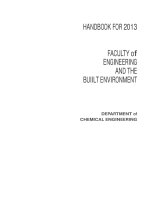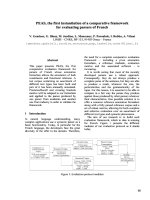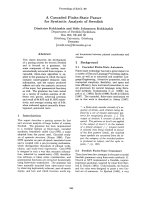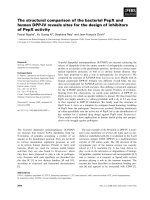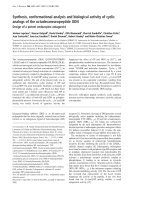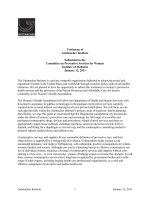HANDBOOK FOR BLAST-RESISTANT DESIGN OF BUILDINGS pot
Bạn đang xem bản rút gọn của tài liệu. Xem và tải ngay bản đầy đủ của tài liệu tại đây (24.54 MB, 486 trang )
HANDBOOK FOR
BLAST-RESISTANT
DESIGN OF BUILDINGS
Handbook
for
Blast-Resistant Design
of
Buildings
Edited by Donald
0.
Dusenberry
Copyright
0
2010
by
John
Wiley
&
Sons,
Inc.
All
rights reserved.
HANDBOOK FOR
BLAST-RESISTANT
DESIGN OF BUILDINGS
Edited by
Donald O. Dusenberry
JOHN WILEY & SONS, INC.
To my wife, Alice
This book is printed on acid-free paper.
∞
Copyright
C
2010 by John Wiley & Sons, Inc. All rights reserved.
Published by John Wiley & Sons, Inc., Hoboken, New Jersey.
Published simultaneously in Canada.
No part of this publication may be reproduced, stored in a retrieval system, or transmitted in any
form or by any means, electronic, mechanical, photocopying, recording, scanning, or otherwise,
except as permitted under Section 107 or 108 of the 1976 United States Copyright Act, without
either the prior written permission of the Publisher, or authorization through payment of the
appropriate per-copy fee to the Copyright Clearance Center, 222 Rosewood Drive, Danvers, MA
01923, (978) 750-8400, fax (978) 646-8600, or on the web at www.copyright.com. Requests to the
Publisher for permission should be addressed to the Permissions Department, John Wiley & Sons,
Inc., 111 River Street, Hoboken, NJ 07030, (201) 748-6011, fax (201) 748-6008, or online at
www.wiley.com/go/permissions.
Limit of Liability/Disclaimer of Warranty: While the publisher and the author have used their best
efforts in preparing this book, they make no representations or warranties with respect to the
accuracy or completeness of the contents of this book and specifically disclaim any implied
warranties of merchantability or fitness for a particular purpose. No warranty may be created or
extended by sales representatives or written sales materials. The advice and strategies contained
herein may not be suitable for your situation. You should consult with a professional where
appropriate. Neither the publisher nor the author shall be liable for any loss of profit or any other
commercial damages, including but not limited to special, incidental, consequential, or other
damages.
For general information about our other products and services, please contact our Customer Care
Department within the United States at (800) 762-2974, outside the United States at (317)
572-3993 or fax (317) 572-4002.
Wiley also publishes its books in a variety of electronic formats. Some content that appears in print
may not be available in electronic books. For more information about Wiley products, visit our
web site at www.wiley.com.
Library of Congress Cataloging-in-Publication Data:
Handbook of blast resistant design of buildings / edited by Donald O. Dusenberry.
p. cm.
Includes index.
ISBN 978-0-470-17054-0 (cloth)
1. Building, Bombproof. I. Dusenberry, Donald O.
TH1097.H36 2010
693.8
54–dc22
2009019203
ISBN: 978-0-470-17054-0
Printed in the United States of America
10987654321
CONTENTS
Preface xv
Contributors xix
I DESIGN CONSIDERATIONS 1
1 General Considerations for Blast-Resistant Design 3
Donald O. Dusenberry
1.1 Introduction 3
1.2 Design Approaches 4
1.3 The Blast Environment 5
1.4 Structure As an Influence on Blast Loads 6
1.5 Structural Response 8
1.6 Nonstructural Elements 9
1.7 Effect of Mass 10
1.8 Systems Approach 12
1.9 Information Sensitivity 13
1.10 Summary 14
References 15
2 Design Considerations 17
Robert Ducibella and James Cunningham
2.1 Introduction 17
2.2 A New Paradigm for Designing Blast-Resistant Buildings,
Venues, and Sites 18
2.3 A Brief History of Recent Terrorist Attacks 21
2.3.1 Terrorists’ Use of Explosives 21
2.3.2 Vehicle-Borne Improvised Explosive Devices 22
2.3.3 Person-Borne Improvised Explosive Devices 24
2.3.4 Locally Available Explosives 25
2.3.5 Some Counterterrorism Considerations 27
2.4 Collaborating to Analyze Risk 28
2.4.1 Step 1—Threat Identification and Rating 28
2.4.2 Step 2—The Asset Value Assessment 31
2.4.3 Step 3—The Vulnerability Assessment 34
v
vi CONTENTS
2.4.4 Step 4—The Risk Assessment 38
2.4.5 Step 5—Considering Mitigation Options 39
2.4.6 The Continuing Role of Risk Management 40
2.5 Consequence Management 42
2.5.1 Consequence Evaluation 44
2.5.2 Function Redundancy 48
2.5.3 Building Location 51
2.5.4 Building Dispersal/Distribution of Functional Programs 54
2.5.5 Disaster Recovery and Contingency Planning 56
2.6 Threat Reduction 57
2.6.1 Accidental Explosions 59
2.6.2 Intentional Explosions 60
2.7 Vulnerability Reduction 63
2.7.1 Standoff Distance 64
2.7.2 Physical Security 65
2.7.3 Operational Security 65
2.7.4 Structural Design 65
2.8 Risk Acceptance 70
2.8.1 Design to Threat 71
2.8.2 Design to Budget 73
2.9 Some Recent Examples of Security Design “Best Practices” 75
2.10 Related Phenomena 76
2.10.1 Progressive Collapse 77
2.10.2 Disruption of Evacuation, Rescue, and
Recovery Systems 79
2.10.3 Attendant Fires 81
2.11 Security Design Consideration Guidelines 83
2.12 Conclusion 84
References 85
3 Performance Criteria for Blast-Resistant Structural Components 87
Charles J. Oswald
3.1 Introduction 87
3.2 Building and Component Performance Criteria 88
3.3 Response Parameters 91
3.4 Empirical Correlations between Response Parameters
and Component Damage 95
3.5 Response Criteria Development 99
3.5.1 Explosive Safety Criteria 99
3.5.2 Response Criteria for Antiterrorism 102
3.5.3 Response Criteria for Blast-Resistant Design of
Petrochemical Facilities 105
3.5.4 Blast Resistant Doors 107
3.5.5 Blast-Resistant Windows 109
CONTENTS vii
3.5.6 Response Criteria for Equivalent Static Loads 112
3.5.7 Comparisons of Published Response Criteria 113
3.6 Response Criteria Limitations 114
References 116
4 Materials Performance 119
Andrew Whittaker and John Abruzzo
4.1 Introduction 119
4.2 Structural Steel 119
4.2.1 Stress-Strain Relationships 119
4.2.2 Constitutive Models for Structural Steel 120
4.2.3 Component Level Strain Rate and Temperature Effects 123
4.2.4 Mechanical Properties for Design 125
4.2.5 Failure Modes of Structural Components 127
4.3 Reinforced Concrete 129
4.3.1 Stress-Strain Relationships for Concrete 129
4.3.2 Stress-Strain Relationships for Reinforcement 132
4.3.3 Constitutive Modeling of Concrete and Rebar 132
4.3.4 Component Level Strain-Rate Effects 136
4.3.5 Mechanical Properties for Design 138
4.3.6 Component-Level Failure Modes 141
4.4 Strength-Reduction Factors for Steel and Reinforced Concrete 144
References 145
5 Performance Verification 149
Curt Betts
5.1 Introduction 149
5.2 Performance Verification 149
5.3 Testing 150
5.3.1 Vehicle Barrier Testing 150
5.3.2 Building Components 151
5.4 Analysis 156
5.5 Peer Review 157
References 157
II BLAST PHENOMENA AND LOADINGS 159
6 Blast Phenomena 161
Paul F. Mlakar and Darrell Barker
6.1 Introduction 161
6.2 Sources of Blasts 162
6.3 Characteristics of Blast Waves 170
viii CONTENTS
6.3.1 Key Parameters 170
6.3.2 Scaling 171
6.4 Prediction of Blast Parameters 172
6.4.1 High Explosives 172
6.4.2 Bursting Pressure Vessels 177
6.4.3 Vapor Cloud Explosions 178
6.5 Summary 181
References 181
7 Blast Loading 183
Paul F. Mlakar and William Bounds
7.1 Introduction 183
7.2 Empirical Method 183
7.2.1 Empirical Method—Basic Blast Wave Example 186
7.3 Front Wall Loads 186
7.3.1 Empirical Method—Front Wall Loading Example 188
7.3.2 Empirical Method—Oblique Angle Example 192
7.4 Side Wall and Roof Loads 192
7.4.1 Empirical Method—Side Wall Loading Example 194
7.4.2 Empirical Method—Roof Loading Example 196
7.5 Rear Wall Loads 197
7.5.1 Empirical Method—Rear Wall Loading Example 197
7.6 Confined Explosions 198
7.7 Leakage 206
7.8 Ray-Tracing Procedures 208
7.9 Summary 212
References 212
8 Fragmentation 215
Kim King
8.1 Introduction 215
8.2 Debris 215
8.3 Loadings 215
8.3.1 Primary Fragmentation 216
8.3.2 Secondary Fragmentation 218
8.4 Design Fragment Parameters 226
8.4.1 Fragment Final Velocity 226
8.4.2 Fragment Trajectory 227
8.5 Fragment Impact Damage 228
8.5.1 Fragment Penetration into Miscellaneous Materials
(THOR Equation) 229
8.5.2 Steel 231
8.5.3 Fragment Penetration into Concrete Targets 233
8.5.4 Fragment Perforation of Concrete Targets 235
CONTENTS ix
8.5.5 Fragment Spalling of Concrete Targets 236
8.5.6 Roofing Materials 236
8.5.7 Other Materials 237
References 237
III SYSTEM ANALYSIS AND DESIGN 239
9 Structural Systems Design 241
Robert Smilowitz and Darren Tennant
9.1 General Discussion 241
9.1.1 Seismic versus Blast 241
9.1.2 Analytical Methods 243
9.2 Modeling 244
9.2.1 Systems 245
9.2.2 Materials 246
9.2.3 Members 248
9.2.4 Connections 251
9.3 Analytical Approaches 252
9.3.1 P-I Diagrams 252
9.3.2 Single-Element Analyses 253
9.3.3 Structural Systems Response 255
9.3.4 Explicit Dynamic Finite Element Analyses 255
9.4 Progressive Collapse 256
9.4.1 European Guidance 258
9.4.2 U.S. Guidance 258
References 261
10 Building Envelope and Glazing 263
Eve Hinman and Christopher Arnold
10.1 Design Intent 263
10.1.1 Life Safety 263
10.1.2 Emergency Egress and Facilitating Search
and Rescue 264
10.1.3 Critical Functions (Protecting Equipment and
Business Processes) 264
10.2 Design Approach 265
10.2.1 Response Criteria 269
10.2.2 Static versus Dynamic 270
10.2.3 Balanced Design 270
10.2.4 Load Path 270
10.3 Fenestration 272
10.3.1 Glass 273
10.3.2 Mullions/Transoms 278
10.3.3 Frame and Anchorage 279
x CONTENTS
10.3.4 Supporting Structure 280
10.3.5 Other Penetrations 280
10.4 Exterior Walls 281
10.4.1 Concrete Walls 282
10.4.2 Masonry 285
10.4.3 Steel 285
10.4.4 Other 286
10.5 Roof Systems 289
10.5.1 Concrete 289
10.5.2 Steel 289
10.5.3 Composite 290
10.5.4 Penthouses/Gardens 290
10.6 Below Grade 290
10.7 Reduction of Blast Pressures 292
References 294
11 Protection of Spaces 297
MeeLing Moy and Andrew Hart
11.1 Areas Isolating Interior Threats 297
11.2 Stairwell Enclosures 298
11.3 Hardened Plenums 298
11.4 Safe Havens 299
11.4.1 FEMA Documents 299
11.4.2 Multi-Hazard Threats 300
11.4.3 Design Requirements for Protective
Shelters 301
References 305
12 Defended Perimeter 307
Joseph L. Smith and Charles C. Ellison
12.1 Goals 307
12.2 Standoff 307
12.2.1 Balancing Hardening with Standoff 309
12.2.2 Balancing Costs 311
12.2.3 Site Planning 313
12.3 Vehicle Control Barriers 316
12.3.1 Crash Testing 316
12.3.2 Crash Modeling 317
12.3.3 Walls 319
12.3.4 Bollards 319
12.3.5 Active Wedge 320
12.3.6 Beam Barriers 320
12.3.7 Cable-Based Systems 323
CONTENTS xi
12.3.8 Planter and Surface Barriers 324
12.3.9 Berms, Ditches, and Other Landscaping
Features 324
12.4 Pedestrian Control Barriers 325
12.5 Blast Walls and Berms 327
References 329
13 Blast-Resistant Design of Building Systems 331
Scott Campbell and James Ruggieri
13.1 Background 331
13.2 Introduction 332
13.3 Design Considerations 333
13.3.1 Level of Protection 334
13.3.2 Blast Pressures 334
13.3.3 Shock Induced by the Structure 335
13.3.4 Equipment/System Anchorage 337
13.3.5 Placement of Critical Systems Equipment and
Control Stations 340
13.3.6 Staffing and Building Operations 340
13.3.7 Construction of Hardened Spaces 341
13.3.8 HVAC and Plumbing Systems 341
13.3.9 Electrical Systems 344
13.3.10 Lighting Systems 346
13.3.11 Other Systems/Considerations 346
13.4 Loading Calculation 348
13.4.1 Blast Pressure 349
13.4.2 In-Structure Shock 352
13.5 Summary 362
References 363
IV BLAST-RESISTANT DETAILING 365
14 Blast-Resistant Design Concepts and Member Detailing 365
Steven Smith and W. Gene Corley
14.1 General 367
14.1.1 Scope 367
14.2 Failure Modes 368
14.2.1 Flexural 368
14.2.2 Diagonal Tension 369
14.2.3 Direct Shear 369
14.2.4 Membrane 369
14.2.5 Stability 370
xii CONTENTS
14.3 Detailing 370
14.3.1 General 370
14.3.2 Splices 371
14.3.3 Columns 372
14.3.4 Beams 375
14.3.5 Beam-Column Joints 377
14.3.6 Slabs 378
14.3.7 Walls 380
References 380
15 Blast-Resistant Design Concepts and Member Detailing: Steel 383
Charles Carter
15.1 General 383
15.1.1 Typical Building Designs 383
15.1.2 Prescriptive Building Designs 384
15.1.3 Performance-Based Building Designs 385
15.2 Blast Effects on Structural Steel and Composite Structures 386
15.2.1 Member Ductility 386
15.2.2 Connection Ductility 386
15.2.3 Overstrength 386
15.2.4 Beneficial Strain-Rate Effects 386
15.2.5 Beneficial Effects of Composite Construction 387
15.2.6 Perimeter Column Design 387
15.2.7 Perimeter Girder Design 387
15.2.8 Slab Design 388
15.3 Analysis and Design of Structural Members 388
15.4 Steel Material Properties for Blast Design 388
15.4.1 Strength Increase Factor (SIF) 389
15.4.2 Dynamic Increase Factor (DIF) 389
15.4.3 Dynamic Design Stress 390
15.5 Design Criteria for Blast Design 390
15.5.1 General 390
15.5.2 Load Combinations 391
15.5.3 Resistance Factor and Factor of Safety 391
15.5.4 Local Buckling 391
15.5.5 Lateral-Torsional Buckling 391
15.5.6 Deformation Criteria 391
15.5.7 Detailing for Specific Failure Modes: 393
15.6 Examples 397
15.6.1 Example 1—Determining Capacities 397
15.6.2 Example 2—Design and Analysis for Blast Loads on
Members 402
15.7 Design of Connections 418
References 419
CONTENTS xiii
16 Blast-Resistant Design Concepts and Member
Detailing: Masonry 421
Shalva Marjanishvili
16.1 General Considerations 423
16.1.1 Masonry 424
16.1.2 Reinforcement 424
16.1.3 Mortar 425
16.1.4 Grout 425
16.1.5 Construction Methods 425
16.2 Failure Modes 426
16.2.1 Flexure 428
16.2.2 Diagonal Tension Shear 431
16.2.3 Direct Shear 432
16.2.4 Breach and Spall Phenomena 432
16.3 Reinforced Masonry Detailing 434
16.3.1 General 435
16.3.2 Longitudinal Reinforcement 435
16.3.3 Horizontal Reinforcement 435
16.3.4 Walls 438
16.3.5 Support Connections 438
16.4 Unreinforced Masonry 439
16.4.1 Performance Evaluation 439
16.4.2 Retrofit Recommendations 440
References 442
17 Retrofit of Structural Components and Systems 445
John E. Crawford and L. Javier Malvar
17.1 Introduction 445
17.2 Retrofit of Columns 446
17.2.1 Reinforced Concrete Columns 446
17.2.2 Steel Columns 454
17.3 Retrofit of Walls 458
17.3.1 Masonry Walls 458
17.3.2 Stud Walls 466
17.4 Floors 466
17.5 Beams/Girders/Connections 468
17.6 Structural System 469
17.7 References 469
17.7.1 Inexact Science 469
17.7.2 Complexities 470
References 470
Index 477
PREFACE
The need for protection against the effects of explosions is not new. The use
of explosive weaponry by the military necessitated resistive entrenchments ages
ago. Industrialization of our societies well over a century ago meant that we
intended to manufacture, store, handle, and use explosives in constructive ways.
To support these military and industrial purposes, a relatively small group of
designers have worked to devise ways to strengthen the blast resistance of our
structures.
Early attempts at blast-resistance design necessarily relied on judgment, test,
and trial-and-error construction to find the best solutions. As technology im-
proved, designers became better able to predict the influences of explosions
and the resistive responses that they strove to impart into their designs. More
recently, in the past several decades chemists, physicists, blast consultants, and
structural engineers have been empowered by technologies and computational
tools that have enhanced the precision of their analyses and the efficiency of their
designs.
At the same time, the need has increased. The small contingent of designers
skilled in the art and science of creating structural designs that will resist ex-
plosive forces has been joined by a larger group of architects, engineers, blast
consultants, and security consultants who are trying to respond to the increas-
ing concern from a broader group of clients who fear an exposure that they did
not anticipate before and frequently did not bring upon themselves. Consultants
who have never before had to assess risks, devise risk-reduction programs, pro-
vide security systems, establish design-base threats, calculate the pressures and
impulses from explosions, and create cost-effective structural designs are being
thrust into the process. Many are ill-trained to respond.
There are several good references on some of the aspects of designing for
blast resistance. Some of these references support military purposes or for other
reasons have government-imposed restrictions against dissemination. As such,
they are not widely available to consultants working in the private sector. Nearly
all those references and the references that are public each treat an aspect of
blast phenomenology, security systems, and structural design for blast resistance,
but few, if any, bring together in one place discussions of the breadth of the
issues that are important for competent designs. Consultants are forced to collect
a library of references and extract from each the salient information that they
then synthesize into a comprehensive design approach.
xv
xvi PREFACE
In addition, practitioners who do receive the limited-distribution references
for the first time or who find references that are public usually discover
immediately that designing for blast resistance is completely different from de-
signing for any environmental load they encountered previously. Designers often
realize quickly that they are embarking on design process for which they do not
have the knowledge or experience for adequate competency. Those who do not
have this realization might be operating at risk if they are not careful and thor-
ough students.
The purpose for this handbook is to bring together into one publication dis-
cussions of the broad range of issues that designers need to understand if they
are to provide competent, functional, and cost-efficient designs. The contributors
to this book are among the most knowledgeable and experienced consultants and
researchers in blast resistant design, and contribute their knowledge in a collab-
orative effort to create a comprehensive reference. Many of the contributors to
this handbook are collaborating in the development of the first-ever public-sector
standard for blast resistant design, being developed contemporaneously with this
handbook by the Structural Engineering Institute (SEI) of the American Soci-
ety of Engineers. While there undoubtedly will be some differences between the
SEI standard and this handbook, many readers will consider these publications
as companions.
This handbook is organized into four parts, each addressing a range of aspects
of blast-resistance design.
Part 1: Design Considerations provides an overview of basic principles.
It has five chapters dealing with general considerations and the design pro-
cess; risk analyses, reduction, and avoidance; criteria that establish accept-
able performance; the science of materials performance under the extraordinary
blast environment; and performance verification for technologies and solution
methodologies.
Part 2: Blast Phenomena and Loadings, in three chapters, describes the
explosion environment, loading functions to be used for blast response analysis,
and fragmentation and associated methods for effects analyses.
Part 3: System Analysis and Design has five chapters that cover anal-
ysis and design considerations for structures. This part instructs on struc-
tural, building envelope, component space, site perimeter, and building system
designs.
Part 4: Blast-Resistant Detailing addresses detailing structural elements for
resistance. Chapters on concrete, steel, and masonry present guidance that is
generally applicable for new design. The fourth chapter addresses retrofits of
existing structures.
I wish to thank all the contributors for their commitment to this work, their
collaborative spirit, and, of course, their willingness to share the blast-related
expertise that they have presented in their chapters. I wish to thank Steven Smith
of CTLGroup in particular, for organizing and harmonizing the four chapters of
Part 4. William Zehrt of the Department of Defense Explosives Safety Board
improved the quality of this handbook by reviewing the chapters of Part 2.
PREFACE xvii
I also wish to thank James Harper, Editor of John Wiley & Sons for sup-
porting this effort; Daniel Magers, Senior Editorial Assistant, and Amy Odum
for her able supervision of the copyediting and production; and the copyeditors,
compositors, typesetters, and others of the publisher’s staff who have profession-
ally assembled this book and brought it to publication.
Donald O. Dusenberry
Wakefield, Massachusetts
CONTRIBUTORS
John Abruzzo, P.E.
Principal
Thornton Tomasetti
555 12th Street, Suite 600
Oakland, CA 94607
Tel: (510) 433-9370
JAbruzzo@ThorntonTomasetti
.com
Christopher Arnold, FAIA, RIBA
President, Building Systems
Development Inc
Palo Alto CA
1248 Waverley Street
Palo Alto, CA 94301
Tel: 650-462-1812
Curt P. Betts, P.E.
Chief, Security Engineering Section
US Army Corps of Engineers
Protective Design Center
1616 Capitol Avenue
Omaha, Nebraska 68102-4901
Tel: (402) 995-2359
Darrell D. Barker, P.E.
Vice President
Extreme Loads and Structural
Risk
ABS Consulting
14607 San Pedro Ave., Suite 215
San Antonio, Texas 78232
Tel: (210) 495-5195
William Bounds, P.E.
Fluor
PO Box 5014
Sugar Land, Texas 77487
william.bounds@fluor.com
Scott Campbell, Ph.D., P.E.
Structural Analysis Consulting
Group
PO Box 91364
Louisville, KY 40291
Tel: (502) 762-9596
Charles Carter
American Institute of Steel
Construction
One East Wacker Drive
Suite 700
Chicago, Illinois 60601-1802
Tel: (312) 670-2400
W. Gene Corley, Ph. D.
CTLGroup
5400 Old Orchard Road
Skokie, Illinois 60077-4321
Tel: (847) 972-3060
Fax: (847) 965-6541
xix
xx CONTRIBUTORS
John E. Crawford
Karagozian & Case
2550 N. Hollywood Way, Suite 500
Burbank, CA 91505-5026
Tel: (818) 240-1919
James D. Cunningham
Williamsburg, Virginia
Tel: (757) 645-4057
Robert Ducibella
Senior Principal
Ducibella Venter & Santore
Security Consulting Engineers
Sturbridge Commons – Franklin
House
250 State Street
North Haven, CT 06473
Tel: (203) 288-6490
Donald O. Dusenberry, P.E.
Senior Principal
Simpson Gumpertz & Heger Inc.
41 Seyon Street, Building 1, Suite 500
Waltham, MA 02453
Tel: (781) 907-9000
Chuck Ellison, P.E.
Senior Security Engineer
Applied Research Associates, Inc.
119 Monument Place
Vicksburg, MS 39180
Phone: (601)638-5401
Andrew Hart, Ph.D., MSc, BEng
(Hons), Aff.M.ASCE
Martinez, CA 94553
Tel: (925) 370-3866
Eve Hinman, Eng.Sc.D., P.E.
President
Hinman Consulting Engineers, Inc.
One Bush Street, Suite 510
San Francisco, CA 94104
Tel: (415) 621-4423
Kim W. King, P.E.
Director of Engineering
2195 Redwoods Crest
San Antonio, TX 78232
Tel: (210) 213-3737
L. Javier Malvar
Naval Facilities Engineering Service
Center
1100 23rd Avenue
Port Hueneme, CA 93043-4370
Shalva M. Marjanishvili, Ph.D.,
P.E., S. E.
Technical Director
Hinman Consulting Engineers, Inc.
One Bush Street, Suite 510
San Francisco, CA 94104
Tel: (415) 621-4423
Paul F. Mlakar, Ph.D., P.E.
U.S. Army Engineer Research and
Development Center
3909 Halls Ferry Road
Vicksburg, MS 39180
Tel: (601) 634-3251
MeeLing Moy, P.E.
President
The Link CE, PLLC
New York
Tel: (646) 385-5096
CONTRIBUTORS xxi
Charles J. Oswald, Ph.D, P.E.
Protection Engineering Consultants
4203 Gardendale, Suite C112
San Antonio, TX 78229
Tel: (512) 380-1988
coswald@protection-
consultants.com
James Angelo Ruggieri, P.E.
10710 Timberidge Road
Fairfax Station, VA 22039
Tel: (703) 250-3671
Robert Smilowitz, Ph.D., P.E.
Weidlinger Associates, Inc.
375 Hudson Street
12th Floor
New York, New York 10014-3656
Tel: (212) 367-3090
Joseph L. Smith, PSP
Senior Vice President
Applied Research Associates, Inc.
119 Monument Place
Vicksburg, MS 39180
Tel: (601) 638-5401
Steven Smith
CTLGroup
10946 Eight Bells Lane
Columbia, MD 21044
Tel: (410) 997-0400
Darren Tennant
Weidlinger Associates, Inc.
6301 Indian School Road, NE,
Suite #501
Albuquerque, NM 87110
Tel: (505) 349-2820
Andrew Whittaker, Ph.D., S.E.
University at Buffalo
Buffalo, NY 14260
Tel: (716) 645-4364
I Design Considerations
Handbook
for
Blast-Resistant Design
of
Buildings
Edited by Donald
0.
Dusenberry
Copyright
0
2010
by
John
Wiley
&
Sons,
Inc.
All
rights reserved.
1 General Considerations for
Blast-Resistant Design
Donald O. Dusenberry
1.1 INTRODUCTION
Until recently, relatively few engineers and architects have had to design struc-
tures and their systems to resist the effects of explosions. Military engineering
personnel, consultants to the federal government, and consultants to industries
that use explosive or volatile materials constituted the primary population of de-
signers routinely analyzing blast effects.
Following the explosion that demolished the Alfred P. Murrah Federal Build-
ing in Oklahoma City in 1995, members of the structural design and construction
industries have been increasingly quizzed by owners about blast-related hazards,
risks, and methods of protection. The types and numbers of clients seeking blast
resistance in their structures have expanded.
The terrorist events of the recent past and the fear that others may occur in the
future have led many businesses, particularly those with an international pres-
ence, to consider their vulnerability. And, of course, as their neighbors work to
enhance the performance of their buildings, owners and tenants who do not en-
vision themselves as targets of malevolent acts nevertheless begin to wonder if
their structures might be damaged as a consequence of their proximity to tar-
gets. Some have argued that adding blast resistance and enforcing standoff for
one building on a block unfortunately increases the threat for others, because it
encourages aggressors to attempt to assemble bigger bombs and detonate them
closer to the target’s neighbors.
There seems to be a sense of anxiety about the vulnerability of our buildings,
bridges, tunnels, and utilities in the midst of numerous recognized international
social and political instabilities, and given the potential for domestic groups and
individuals to seek influence and create disruption by resorting to violent means.
As a result, consultants designing rather pedestrian buildings now are expected to
provide advice and sometimes specific enhancements in response to quantifiable
threats, as well as perceived vulnerabilities.
In this environment, engineers need training and information so that they can
provide designs that effectively enhance a building’s response to explosions.
3
Handbook
for
Blast-Resistant Design
of
Buildings
Edited by Donald
0.
Dusenberry
Copyright
0
2010
by
John
Wiley
&
Sons,
Inc.
All
rights reserved.
4 GENERAL CONSIDERATIONS FOR BLAST-RESISTANT DESIGN
1.2 DESIGN APPROACHES
Most engineers and architects serving clients with growing interest in blast re-
sistance are uninitiated in the relevant design practice. Blast loading is very dif-
ferent from loadings commonly analyzed by structural engineers. Peak pressures
are orders of magnitude higher than those associated with environmental loads,
but their durations generally are extremely short compared to natural periods of
structures and structural components. In addition, given that the risk of an ex-
plosion at any one facility normally is very low and the costs to achieve elastic
response often are prohibitive, designs usually engage the energy-dissipating ca-
pability of structural and enclosure elements as they are deformed far into their
inelastic ranges. This forces engineers to account for geometric and material
nonlinearities.
At first, designing for blast resistance might sound similar to designing for
seismic resistance because neither is static and both rely on post-yield response.
But even those similarities are limited. The dominant frequencies of seismic ex-
citations are on the order of the lowest natural frequencies of building response,
not much faster, as is generally the case for blast loadings. Blast loading usually
is impulsive, not simply dynamic.
While we tolerate some damage in earthquakes, to dissipate energy, we usu-
ally allow more damage for blast events. We expect facades to sustain severe
damage. In fact, blast-resistant design often tolerates breaching of the building
enclosure (with attendant risk of fatalities) and even sometimes partial collapse
of buildings.
Many blast-resistant designs require very sophisticated approaches for the
analysis of building response to explosions (National Research Council 1995).
There are techniques for accurate assessment of blast pressures and impulses
in complicated environments, modeling the influence of those blast loadings on
surfaces, and structural response to those loads. There are critical facilities and
blast conditions that warrant the use of these techniques. However, much blast-
resistant design is performed following simplified procedures (U.S. Department
of Defense 2008) that approximate actual conditions, and therefore lack high
fidelity. This often is appropriate because of, and at least in part follows from,
inevitable uncertainties that mask the phenomenon and the structure’s response.
In addition, there are practical matters of prudence, economics, and risk accep-
tance that drive analyses of blast response.
Risk analyses are important components of the design for blast resistance
(Federal Emergency Management Agency 2003). Among the products of such
analyses are estimates of the threat for which a structure should be designed. The
magnitude of intentional, nonmalevolent explosions and industrial explosions
sometimes can be estimated with precision commensurate with that of other
common loadings (Center for Chemical Process Safety 1996). The quantity of
explosive materials can be estimated, the potential locations of the design-base
explosion can be isolated, and often there are relatively few nearby objects that
significantly affect the shock front advance.
THE BLAST ENVIRONMENT 5
This is not the case for many accidental explosions and most malevolent ex-
plosions. The assessment of the threat in these instances often does not have a
probabilistic base. When sufficient data do not exist, consultants are forced to
use judgment rather than hard science to establish the threat.
When data are not available, consultants often establish the magnitude of the
threat of a malevolent explosion by assessing the probable size of the container
(e.g., letter, satchel, package) in which a bomb is likely to be delivered (U.S.
Department of Defense 2002a), and then selecting a design-base explosive mass
based on a fairly arbitrary assignment of the quantity of explosive that could
reasonably be accommodated in that container. In these cases, there is relatively
high uncertainty about the intensity of the explosion that might actually occur.
Obviously under these circumstances, there is a commensurate level of uncer-
tainty about the outcome.
1.3 THE BLAST ENVIRONMENT
Engineers skilled in the design of buildings for occupancy-related and environ-
mental loads (e.g., dead, live, wind, snow, and seismic loads), but faced with a
new challenge to design for blast loads, often find themselves ill-equipped for
the challenge. Designers are used to treating all other common loadings as either
static or quasi-static, because the rise time and duration for the equivalent load
are on the order of, or longer than, the longest natural periods of the structure.
Designing for blast loading generally cannot follow this approach.
Conventional design for common time-varying loads, including wind and
seismic, includes techniques that allow conversion of these dynamic phenomena
into quasi-static events that recognize and simplify the dynamics. Wind loads
defined in one of the most common references (American Society of Civil Engi-
neers 2005) are based on an acknowledgment of the range of natural frequencies
of common structural frames, and are calibrated to those values. When the fre-
quency of a subject building falls outside of that default range, common design
approaches provide for specified adjustments to the quasi-static design loads to
account for dynamic response.
Common seismic design (American Society of Civil Engineers 2005) involves
a very elaborate conversion of the dynamic loading environment into a quasi-
static analysis problem. Building systems are characterized for stiffness and duc-
tility, and site conditions are evaluated for seismic exposures and characteristics
of shaking. On the basis of extensive research into building performance and a
fair amount of cumulative experience evaluating the actual earthquake response
of designed structures, the complicated loadings—which are as much a function
of the building design as they are of the environment in which structures are
built—are idealized as a series of externally applied loads that are thought to
mimic the loading effects of an earthquake. Complicated though the approach is,
many buildings can be designed for earthquakes by engineers with little famil-
iarity with dynamic behavior.
6 GENERAL CONSIDERATIONS FOR BLAST-RESISTANT DESIGN
Our conventional approach to blast design is similar to that for seismic design,
in two important ways: (1) both loadings clearly are dynamic and, hence, solu-
tions are energy-based, and (2) the way we detail structural elements determines
the effective loads for which structures must be designed (meaning, we limit the
strength we need to supply by allowing post-elastic behavior to dissipate energy).
However, blast loading, with its extremely fast rise time and usually short dura-
tion, is either dynamic or impulsive, depending on the nature of the explosive, its
distance from the subject structure, and the level of confinement that the structure
creates for the expanding hot gases (Mays and Smith 1995).
The impulsive form of the very fast load rise time and very short load dura-
tion normally associated with blast loading requires analytical approaches that
generally demand direct solution of energy balance equations (U.S. Department
of Defense 2008; Mays and Smith 1995).
1.4 STRUCTURE AS AN INFLUENCE ON BLAST LOADS
The pressure and duration of the impulse associated with a blast are influenced
by reflections of the shock front (U.S. Department of Defense 2008). Reflection
sources include the ground below the detonation point and building surfaces that
have sufficient mass or ductility to remain largely in place for the duration of the
impulse. When shock fronts are reflected, their pressures are magnified as a func-
tion of the proximity, robustness, and material characteristics of the impacted ob-
ject (Bangash 1993). The more robust that object, the greater the reflected energy
because less energy is dissipated by the response (such as ground cratering) of
the surface. These variations often are neglected in conventional design.
For instance, facades normally are designed on the assumption that they are
perfect reflectors of the shock front. Designers following common procedures
are assuming that the facade components remain stationary for the duration of the
impinging shock front, causing peak pressures and impulses sufficient to reverse
the direction of the shock front. In practice, there can be some displacement of
the facade during the loading cycle. This displacement reduces the effectiveness
of the reflector, and correspondingly the impulse.
Analyses for interior explosions have additional complications, as designers
attempt to deal with the multiple reflections of the shock front within the struc-
ture, and pressures that develop from containment of expanding hot gases (Mays
and Smith 1995)–a phenomenon normally neglected for external explosions.
Further, the geometry of the confining volume and the location of the explo-
sion within the volume can substantially affect the pressures on surfaces (U.S.
Department of Defense 2008). The science that describes the pressure history on
interior surfaces is complex, and not generally considered rigorously in common
blast-resistant design processes.
Providing blast venting through frangible components to mitigate the effects
of interior explosions is even more complex, since the release time for the venting
component is a key, but difficult to assess, factor in the determination of the
STRUCTURE AS AN INFLUENCE ON BLAST LOADS 7
magnitude of the pressure buildup. Approximations usually govern the analyses
(U.S. Department of Defense 2008).
Clearly, there is interplay between the performances of building facades and
frames. While in most cases the primary reason we enhance the performance
of a facade is to protect occupants, we gain protection for the structure as well.
Blast shock fronts that are not repelled by the facade will advance into a building,
inducing pressures on interior surfaces of the structure and threatening interior
columns, walls, and floor systems. Blast-related upward impulses on floor slabs
can reverse force distributions in these structural elements. In systems that are
not strong and ductile enough for these reversed forces, blast-induced deflections
can fracture structural elements that are required to resist gravity loads. Hence,
floor systems can fail after the direct effects of the blast pass and the slab falls
back downward under the influence of gravity.
Of course, by designing the facade to resist the effects of an explosion, the de-
signer is forcing the structure to become a support for the blast loads. Depending
on the performance criteria, designers need to demonstrate that the framing sys-
tem can support the applied loads, and that the structure as a whole will remain
standing with an acceptable level of damage.
Building enclosures normally are designed to resist blast effects by inelastic
flexural action, but it is possible to design facades to resist blast effects through
catenary action as well. In particular, blast retrofits sometimes include new
“catch systems” that are intended to reduce intrusion of blast pressures and cre-
ation of lethal missiles, by acting as a net inside the original exterior wall system.
In any case, the lateral displacement of the system often is large enough to
open gaps between wall panels or between panels and floor slabs. When this
happens, there is potential for leakage pressures to enter the building (U.S. De-
partment of Defense 2002b), even when windows stay in place. This is partic-
ularly true in response to large, relatively distant explosions that have relatively
long-duration impulses.
Pressure fronts that leak past facades that are damaged but remain in place
normally are assumed to have insufficient energy to induce significant damage to
interior structural components. However, these leakage pressures can cause per-
sonal injuries and damage to architectural and mechanical systems if they are not
designed for resistance.
Add to the effects of leakage pressures the possibility that structural and ar-
chitectural features on the inward-facing surfaces of facade components can
become missiles when the facade sustains damage as it deforms, and there re-
mains substantial risk to occupants inside blast-resistant buildings even with
well-developed designs.
It is well established that breached fenestration leads to lethal missiles and
internal pressurization (American Society of Civil Engineers 1999). Common
design for blast resistance for malevolent attacks often is based on the premise
that a significant fraction of the fenestration in a building will fail (General Ser-
vices Administration 2003). This is due in part to the variability of the properties
of glass, but also results from risk acceptance that employs the philosophy that
8 GENERAL CONSIDERATIONS FOR BLAST-RESISTANT DESIGN
an explosion is unlikely and that full, “guaranteed” protection is prohibitively
difficult or expensive.
Hence, the effects of leakage pressures and missiles that are the product of
building materials fracturing in response to a blast often can be destructive to the
interiors of buildings, even when the facades of those buildings are designed to
resist the effects of an explosion. Except when the most restrictive approaches to
blast-resistant design are employed (e.g., with elastic response, so a building can
remain functional), parties with standing in the design process need to under-
stand that substantial interior damage and occupant injuries are possible should
the design-base explosion occur.
1.5 STRUCTURAL RESPONSE
The shock front radiating from a detonation strikes a building component, it is
instantaneously reflected. This impact with a structure imparts momentum to ex-
terior components of the building. The associated kinetic energy of the moving
components must be absorbed or dissipated in order for them to survive. Gener-
ally, this is achieved by converting the kinetic energy of the moving facade com-
ponent to strain energy in resisting elements. Following the philosophy that blast
events are unusual loading cases that can be allowed to impart potentially unre-
pairable damage to structures, efficiency in design is achieved through post-yield
deformation of the resisting components, during which energy can be dissipated
through inelastic strain.
Of course, this means that the components that need evaluation often are de-
formed far beyond limits normally established for other loading types, and many
of the assumptions that form the basis for conventional design approaches might
not be valid. For instance, recognition of the extreme damage state normally
associated with dissipation of blast energy has led to debate about appropriate
values of the strength reduction factors ( factors) to be used for design.
In conventional design (American Concrete Institute 2005; American Insti-
tute of Steel Construction 2005), the nominal strengths of structural elements
are reduced by factors to account for uncertainty in the actual strength of
the elements, and for the consequences of failure. Their magnitudes for con-
ventional design have been developed based on studies of structural responses
that are commensurate with service performance of buildings and, for seis-
mic design, responses that are anticipated to be sufficiently limited and duc-
tile to allow elements to retain most of their original load-carrying capacity.
Blast resistance, on the other hand, often takes structural elements far into
the inelastic range, to where residual strengths might be reduced from their
peaks, and alternative load-carrying mechanisms (e.g., catenary action) are en-
gaged. Sometimes, designers anticipate complete failure of certain elements
if they are subjected to the design-base event. In this environment, it is not
at all clear that factors developed for conventional, nonblast design are
relevant.
